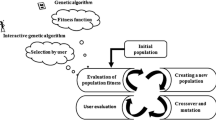Abstract
There has been considerable interest in using evolutionary algorithms based techniques to design creative systems. However,these techniques suffer from either being too creative and violating design constraints of the domain or those catering to a limited search space, but operating within design constraints. We have designed a new evolutionary system ‘HIER-HEIR’, which is not only creative (searches a large space effectively), but creates only such designs which are valid with respect to the design domain. Inspired by human design methodology, the representation is a hierarchy of components and variation acts at all levels of hierarchy intelligently, facilitating effective search in the design space with explicit control over exploitation and exploration. We have explained our technique with the metaphor of automatic design of a fashion dress in this paper. The experimental results validate our hypotheses with regard to the system. With regard to previous work, our technique is new both with regard to previously published hierarchical systems and those designed for evolving fashion designs.
Access this chapter
Tax calculation will be finalised at checkout
Purchases are for personal use only
Preview
Unable to display preview. Download preview PDF.
Similar content being viewed by others
References
Bentley, P.J., Wakefield, J.P.: Hierarchical crossover in genetic algorithms. In: Proceedings of the 1st On-line Workshop on Soft Computing (WSC1), pp. 37–42 (1996)
Grimbleby, J.B.: Hybrid genetic algorithms for analogue network synthesis. In: Proceedings of Congress on Evolutionary Computation (CEC 1999), Washington, DC. Press (1999)
Hemberg, M., O’Reilly, U.-M., Menges, A., Jonas, K., Gonçalves, M., Fuchs, S.: Genr8: Architects’ experience with an emergent design tool. In: The Art of Artificial Evolution, pp. 167–188 (2008)
Hornby, G.S., Lipson, H., Pollack, J.B.: Generative representations for the automated design of modular physical robots. IEEE Transactions on Robotics and Automation 19, 703–719 (2003)
Kicinger, R., Arciszewski, T., De Jong, K.A.: Generative design in structural engineering. In: ASCE International Conference on Computing in Civil Engineering (2005)
Kim, H.-S., Cho, S.-B.: Knowledge-based encoding in interactive genetic algorithm for a fashion design aid system. In: GECCO, p. 757 (2000)
Koza, J.R., Bennett III, F.H., Andre, D., Martin, A., Dunlap, F.: Automated synthesis of analog electrical circuits by means of genetic programming. IEEE Transactions on Evolutionary Computation 1, 109–128 (1997)
Leenaerts, D., Kruiskamp, W.: Darwin: Cmos opamp synthesis by means of a genetic algorithm. In: Design Automation Conference, pp. 433–438 (1995)
McConaghy, T., Palmers, P., Gielen, G., Steyaert, M.: Genetic programming with reuse of known designs for industrially scalable, novel circuit design. In: GPTP V, pp. 159–184 (2008)
Montana, D.J.: Strongly typed genetic programming. Evol. Comput. 3(2), 199–230 (1995)
Ogata, Y., Onisawa, T.: Interactive clothes design support system. In: Ishikawa, M., Doya, K., Miyamoto, H., Yamakawa, T. (eds.) ICONIP 2007, Part II. LNCS, vol. 4985, pp. 657–665. Springer, Heidelberg (2008)
Author information
Authors and Affiliations
Editor information
Editors and Affiliations
Rights and permissions
Copyright information
© 2010 Springer-Verlag Berlin Heidelberg
About this paper
Cite this paper
Malhotra, A., Aggarwal, V. (2010). HIER-HEIR: An Evolutionary System with Hierarchical Representation and Operators Applied to Fashion Design. In: Deb, K., et al. Simulated Evolution and Learning. SEAL 2010. Lecture Notes in Computer Science, vol 6457. Springer, Berlin, Heidelberg. https://doi.org/10.1007/978-3-642-17298-4_21
Download citation
DOI: https://doi.org/10.1007/978-3-642-17298-4_21
Publisher Name: Springer, Berlin, Heidelberg
Print ISBN: 978-3-642-17297-7
Online ISBN: 978-3-642-17298-4
eBook Packages: Computer ScienceComputer Science (R0)




